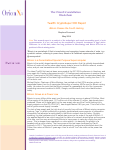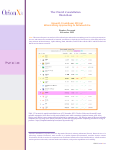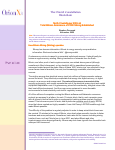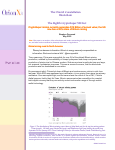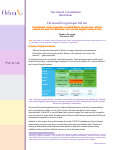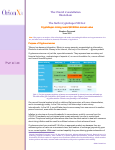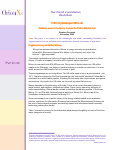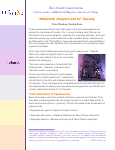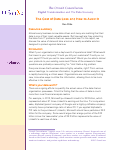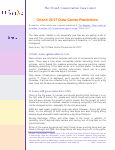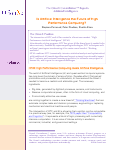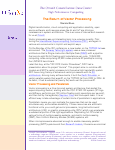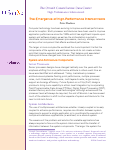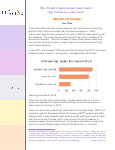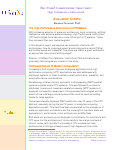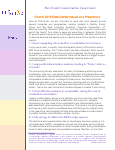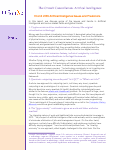Constellation™ Research Reports
The following reports are available for download.
Please click on the image or headline to go directly to the full report. No registration or payment is required.
Please contact us for other published or custom reports.
Fourteenth CryptoSuper 500 List – Report
With 16 years of history behind it, and increasing acceptance globally, Bitcoin is now a two trillion-dollar asset, available for sale through various exchanges, as well as Exchange Traded Funds (ETF) from traditional financial institutions. The fourth halving of the block reward was in April 2024, and 19.87 million bitcoins have now been issued out of the 21 million maximum supply. Bitcoin’s hash rate and price have both increased by a factor of more than 16 since the first CryptoSuper500 report in November 2018. Hash rate per second is the standard metric for the computational power of bitcoin miners, just as floating point operations per second (flops) are the metric in the HPC/AI world.
Fourteenth CryptoSuper 500 List – Slides
A slide presentation describing our Fourteenth CryptoSuper 500 report. Now 6 and 1/2 years of tracking the mining and minting activities of proof of work coins including Bitcoin, Dogecoin in the present list. Bitcoin constitutes the world’s largest decentralized supercomputer network, with an aggregate hash rate of 900 Exahashes/second. All of the hyper scalar GPU systems combined would be unable to win a single block of the Bitcoin blockchain vs. this network since there are several million servers based on highly optimized ASICs designed for the particular hashing algorithm employed.
Digital Transformation
Constellation Summary
Report Type: Evolution
Thirteenth CryptoSuper 500 List – Report
The latest OrionX Constellation Blockchain report underscores Bitcoin’s dominance as the world’s largest decentralized supercomputer, harnessing massive computational power to sustain its $12 billion annual economic value generation. Despite significant market fluctuations, Bitcoin’s robust infrastructure and relentless hashing power, driven by sophisticated ASIC technologies and increasingly prevalent liquid-cooling methods, continue to propel it forward. Regulatory attitudes vary globally, with countries such as the U.S. potentially establishing strategic Bitcoin reserves, while institutions like the European Central Bank view its rising value as a threat to financial stability. Meanwhile, publicly traded mining firms are rapidly expanding into AI and HPC hosting, diversifying their revenue streams to mitigate volatility and sustain growth amidst fierce mining competition.
Twelfth CryptoSuper 500 List – Slides
The CryptoSuper 500 report from November 2024 highlights the significant evolution and consolidation of cryptocurrency markets over the past six years, noting that only Bitcoin and Dogecoin remain dominant in the proof-of-work mining space, generating over $13 billion annually. Bitcoin, notably, now has a market capitalization of $1.8 trillion and operates with a network power exceeding 700 exahashes per second. Its mining industry, increasingly dominated by publicly traded North American companies, has become significantly greener, with approximately 60% of energy sourced from sustainable methods. Despite the challenges of the recent reward halving, Bitcoin continues to follow strong, predictable growth patterns, supported by technological advancements and expanding usage of renewable energy.
Digital Transformation
Constellation Summary
Report Type: Evolution
Twelfth CryptoSuper 500 List – Report
Our first CryptoSuper500 report was five and a half years ago, in November 2018. While there are over 20,000 “cryptocurrencies” that have been created in the interval, only 52 of these coins including stable coins tied to fiat have valuations above $2 billion. Most projects have been abandoned or are worth little; most were essentially get-rich quick schemes for their initiators. Only a small number of coins have used proof of work consensus algorithms; the ones that do not are more properly considered tokens.
The Bitcoin market cap has grown in line with the 6th power of its age over this interval, one would have predicted growth by a factor of 12.5 and it grew quite close to that ratio. For price one would have predicted a factor of 10 and it grew by that same factor. Bitcoin annual production has grown by a smaller factor of 2.8 because there have been two halvings in the block subsidy during the past 5-1/2 years, in May 2020 and April 2024.
Twelfth CryptoSuper 500 List – Slides
This our Twelfth semiannual report on the global Cryptocurrency mining industry. Bitcoin has emerged as the world’s largest, albeit special purpose, supercomputer. And it is globally decentralized. Millions of nodes all run the same open-source code to secure the Bitcoin network, create value, and put new transactions onto the distributed ledger. The latest Top500 list has just been announced at the ISC 2024 conference in Hamburg, and once again the Frontier supercomputer with 1.2 Exaflops peak performance is number one on the list.
Specialization is a current topic in future supercomputers and some lessons can be learned from Bitcoin. If assigned to SHA-256 hashing, Frontier would provide only the equivalent hash rate of about three cabinets of the latest high-end Bitcoin mining systems, costing less than 0.1% of Frontier’s cost. Michael Saylor, Chairman of MicroStrategy, has pointed out that GPUs are two orders of magnitude slower than the 5-nanometer technology of custom ASICs used for Bitcoin mining today. He makes the point that the Bitcoin network is unassailable by all of the hyperscale computing resources combined in AWS, Google, and Microsoft Azure cloud data centers today.
Digital Transformation
Constellation Summary
Report Type: Evolution
Eleventh CryptoSuper 500 List – Report
The first CryptoSuper 500 report was released five years ago in November 2018. Since that time there has been consolidation from six POW coins down to just two, Bitcoin and Dogecoin, that now pass the hurdle for the list. The Bitcoin market capitalization has compounded at 43% per annum over the interval and the global hash rate at 56% per annum. Both have risen faster than Moore’s Law. The annual production of top cryptocurrencies has grown more modestly, at 16% compounded per annum. The more modest rate of increase is a result of Ethereum switching to proof of stake and dropping out of the crypto super POW race in September 2022. The report also discusses central bank digital currencies (CBDCs). China was the first major country to implement such a currency. Having completed its investigation phase, it appears that the European Central Bank is committed to a CBDC, with a preparation phase starting earlier this month.
Eleventh CryptoSuper 500 List – Slides
The computational resources that create and maintain Bitcoin execute a Reusable Proof of Work (POW) security protocol and comprise a decentralized supercomputer with millions of specialized ASICs that perform about 500 Exahashes/second of secure protocol calculations, that is, half a Zettahash/second. The top 12 publicly traded Bitcoin mining companies have a collective market cap of over $8 billion and hold over $1 billion in Bitcoin in their corporate treasuries. They have roughly 100 Exahashes/sec of hash rate and they mine 20% of the 900 Bitcoins mined on an average day, primarily in North America.
Digital Transformation
Constellation Summary
Report Type: Evolution
Tenth CryptoSuper 500 List – Report
We began this series of crypto super reports four and a half years ago to understand the intersection of cryptocurrencies and supercomputing. What we have observed during this interval is the increasing dominance of Bitcoin in terms of both the computing power utilized and the associated market capitalization. Now we have a dozen pools brokering most of $10 billion worth of annual economic value, almost all from Bitcoin, and with about $1 billion of that in transaction fees while 90% is due to the value of new coinage.
Tenth CryptoSuper 500 List – Slides
Bitcoin continues its dominance of the crypto world. There are now a dozen pools brokering most of $10 billion worth of annual economic value, almost all from Bitcoin, and with about $1 billion of that in transaction fees while 90% is due to the value of new coinage. China has abandoned its former dominance of the industry as it seeks to promote a central bank digital currency alternative. The US has emerged as the #1 geography for Bitcoin minting, driven by substantial venture capital investment. About half of the North American hash rate is found within publicly traded companies.
Digital Transformation
Constellation Summary
Report Type: Evolution
Ninth CryptoSuper 500 List – Report
With Ethereum’s change in consensus algorithm in September, away from the security-first proof-of-work for token creation to the transaction speed-first proof-of-stake, and the current crypto winter in prices, cryptocurrency mining pools produced at a rate of less than $7B annual economic value (AEV), down from over $42 billion a year ago. The list is now completely dominated by Bitcoin, showing an AEV of $5.8 billion, down from $20 billion one year ago. Dogecoin is the new #2, but is much smaller in generated annual economic value.
Ninth CryptoSuper 500 List – Slides
Our Ninth CryptoSuper500 list. As of this report the economic value of newly generated Bitcoin has dropped to $6.2 billion from $9.7 billion since OrionX’s prior report in June of this year. Ethereum mining was also generating $9.4 billion in value at that time, but that has collapsed to zero as of mid-September with the Merge and full conversion to proof of stake. Since our first list, produced four years ago, global hash rate has increased by a factor of 5.2 in four years, for a compound annual growth rate (CAGR) of 51%. Bitcoin’s value is up more modestly, with a CAGR around 25% since November 2018, but the price remains highly volatile; very recently volatility has been similar to that of the NASDAQ stock index.
Digital Transformation
Constellation Summary
Report Type: Evolution
Eighth CryptoSuper 500 List: $19B Annual Value, US Leads BTC Mining with 38% – Report
We make three observations for the decline in BTC price in dollars. The first is the unfavorable macroeconomic backdrop. While inflation has been rising worldwide, the growth rate in most countries has been falling as the “post-COVID” bounce in economies wore off, and as COVID didn’t end even while becoming more endemic, and as supply chain disruptions cut activity in some sectors. And for the last three months the world has experienced the brutal invasion of Ukraine and the sanctions on Russia, further slowing economic activity while also contributing to inflation.
Eighth CryptoSuper 500 List: $19B Annual Value, US Leads BTC Mining with 38% – Slides
“Despite the large price drop since our last list, the economic value of Bitcoin mining has risen at a 28% compound annual growth rate, while that of Ethereum has risen at 91% compounded since our first list was published in November of 2018,” said Dr. Stephen Perrenod, OrionX Partner and Analyst and the developer of the CryptoSuper500.
Digital Transformation
Constellation Summary
Report Type: Evolution
Seventh CryptoSuper 500 List: $42B Economic Value – Report
Bitcoin and Ethereum have achieved a production level of $20 billion per year (annual economic value). Bitcoin has reached a market cap of $1.2 trillion and Ethereum is approaching $0.6 trillion. Together they are responsible for over 60% of all cryptocurrency market capitalization. In a world of 13,000 current cryptocurrencies with nearly $3 trillion market cap, only 22 coins have market caps over $10 billion.
Seventh CryptoSuper500 List: $42B Annual Economic Value
The annual economic value of cryptocurrency mining has grown at a compounded annual growth rate of 97% since we tabulated our first CryptoSuper list three years ago,” said Dr. Stephen Perrenod, OrionX Partner and Analyst and the developer of the CryptoSuper500. ““Despite the Chinese ban on bitcoin mining enforced in June of this year, the total global mining hash rate recovered to prior levels in a matter of months.”
Digital Transformation
Constellation Summary
Report Type: Evolution
Sixth CryptoSuper500 List: DeFi, NFT, China
As of May 29th 2021, almost all the produced value by cryptocurrency mining is in three coins: Ethereum’s ETH coin, Bitcoin, and Dogecoin. While Bitcoin continues to represent the top spot in mining power, ETH produced the most mining revenue, aided by emerging applications that offer Decentralized Finance (DeFi) or manage Non-Fungible Tokens (NFTs). Trends to watch include …
Sixth CryptoSuper500 List: Economic Value Nears $40B
Reaching nearly $40 billion in annual economic value, cryptocurrency mining continues to play an impotrant role, aided by emerging applications that offer Decentralized Finance (DeFi) or manage Non-Fungible Tokens (NFTs). This report and associated slide presentation presents an overview of market forces and details of the top 45 pools for Ethereum, Bitcoin, and Dogecoin.
Digital Transformation
Constellation Summary
Report Type: Evolution
Fifth CryptoSuper500 List: Exascale Hashrates
Cryptocurrencies have reached Exascale class supercomputing, with a hash rate of around 115 ExaHashes per second just for Bitcoin. The Bitcoin hash rate is roughly flat since the last Bitcoin halving in May, but due to the strong Bitcoin price rise, the Annual Economic Value (AEV) has grown significantly. AEV of cryptocurrencies that rely on proof of work mining has hit a new high of around $9 billion, despite the Bitcoin Halving of block reward in May. AEV is up 90% since the June 2020 list.
Fifth CryptoSuper500 List: Economic Value Hits New High
Cryptocurrencies have reached Exascale class supercomputing, with a hash rate of around 115 ExaHashes per second just for Bitcoin. The Bitcoin hash rate is roughly flat since the last Bitcoin halving in May, but due to the strong Bitcoin price rise, the Annual Economic Value (AEV) has grown significantly. AEV of cryptocurrencies that rely on proof of work mining has hit a new high of around $9 billion, despite the Bitcoin Halving of block reward in May. AEV is up 90% since the June 2020 list.
Digital Transformation
Constellation Summary
Report Type: Evolution
Fourth CryptoSuper500 List: Post Third Halving
The aggregate annual economic value of crypto production is now about $5 billion. It has fallen back by one-third due to May’s Bitcoin Halving event which reduces block rewards each four years. Since prices tend to move higher for Bitcoin, it is reasonable to expect a recovery. There are over a million mining rigs around the world just for Bitcoin, adding up to a total of some 100 Exahashes per second of power. China has most of the top 50 cryptocurrency supercomputer-class mining pools. The cost of electricity and transaction costs will play critical roles.
The Top-5 Technologies All Organizations Must Understand
Talk given at the Stanford HPC-AI Conference. We discuss the digital infrastructure of the future enterprise and the state of critical technology trends. OrionX works with clients on the impact of Digital Transformation on them, their customers, and their messages. Generally, they want to track, in one place, trends like IoT, 5G, AI, Blockchain, and Quantum Computing. And they want to know what these trends mean, how they affect each other, and when they demand action, and how to formulate and execute an effective plan. This talk is a somewhat technical summary of such discussions.
Digital Transformation
Constellation Summary
Report Type: Evolution
Third CryptoSuper500 List: A Hundred ExaHashes
There are now over 4000 cryptocurrencies. Most are worth relatively little, and only 13 have market caps over $1 billion. Market cap is the number of coins or tokens outstanding times the price. In an extreme illustration of the Pareto principle, two-thirds of the market cap of all cryptocurrencies combined is with Bitcoin, the premier crypto.
CryptoSuper500: 3rd Edition, November 2019
The CryptoSuper500 tracks decentralized supercomputers that are used for cryptocurrency mining, an intensive application that has become a driver of technology development and investment decisions globally. There are now over 4000 cryptocurrencies. Most are worth relatively little, and only 13 have market caps over $1 billion. Market cap is the number of coins or tokens outstanding times the price. In an extreme illustration of the Pareto principle, two-thirds of the market cap of all cryptocurrencies combined is with Bitcoin, the premier crypto.
Digital Transformation
Blockchain & Cryptocurrencies
Report Type: Event
Libra, Corporate Money to Take Cryptocurrency Mainstream
Facebook’s commanding global digital presence can drive adoption and take the cryptocurrency concept to the mainstream. However, Libra compromises on too many attributes of the ideal cryptocurrency to be categorized as anything but a walled-garden Corporate money, and barely a “crypto” currency at that. Libra could have been something better, let’s call it Solar.
CryptoSuper500: 2nd Edition, June 2019
Cryptocurrency Supercomputing refers to large-scale cryptocurrency mining operations which are typically powered by accelerator technologies such as GPUs, FPGAs, or custom ASICs. Bitcoin is the most notable of such currencies. The CryptoSuper500 list tracks supercomputer class systems that are used for cryptocurrency mining, an intensive application that has become a driver of technology development and investment decisions globally. Cryptocurrency mining via Proof of Work is important since it continues to represent the most effective consensus algorithm to maximize security in a decentralized manner.
Digital Transformation
Blockchain & Cryptocurrencies
Report Type: Event
Cryptocurrency Outlook 2019
We provide our views of the cryptocurrency economy in the next 9-15 months and review the accuracy of our last outlook from last year. Topics that are covered include Ethereum and Smart Contracts, Bitcoin and Lightning, Security Tokens, Stablecoins, Enterprise Blockchains and Distributed Ledger Technology, Cryptocurrency Phones, Messenger Coins, and Retail Killer Apps. We begin with definitions and a glossary of terms.
CryptoSuper500: Top Cryptocurrency Supercomputers
The CryptoSuper500 list tracks supercomputers that are used for cryptocurrency mining, an intensive application that has become a driver of technology development and investment decisions globally. The growth of the cryptocurrency market has put the spotlight on emerging decentralized applications, the new ways in which they are funded, and the software stack on which they are built. Cryptocurrency technologies include blockchain, consensus algorithms, digital wallets, and utility and security tokens.
Digital Transformation
Blockchain & Cryptocurrencies
Report Type: Event
Behavioral Analytics and IoT Security
Security threats come from multiple directions, external and internal. Over the years, several approaches have been devised to protect data and/or to avoid service disruptions. In general, OrionX formulates three dimensions of cybersecurity:
- Regulate who gets in: Network Access Control
- Regulate what gets in: Malware Detection & Deep Packet Inspection
- Regulate behavior: Behavioral Analytics & Wide Packet Inspection
Blockchain & Cryptocurrencies – Why What When
Blockchain, cryptocurrencies, smart contracts have emerged as unignorable technologies, with potentially far-reaching implications. The talk covered the essence of these technologies, focusing on what is real, what is a promise, impact on other key trends such as IoT, AI, and Quantum Computing, and why they might or might not deliver on their promises. Smart contracts and ICOs will be covered in a future presentation. Contact us if you’d like to request a speaker.
(This is the full slide deck supporting a keynote speech given at the Advanced Scale Forum conference in 2018.)
Digital Transformation
Blockchain & Cryptocurrencies
Report Type: Event
Cryptocurrency Outlook: More Chasm Crossing
In this paper, we provide our views of the cryptocurrency economy in the next 9-15 months. The only thing more difficult than forecasting the near future is forecasting for longer time frames, and with the rapidly evolving cryptoeconomy, forecasting for a whole year is dangerous enough. Make no mistake, cryptocurrencies are money.
Despite the attempts of economists and money center bankers and central bankers to fight this reality, the leading cryptocurrencies are money in varying degrees. The major ones are not as significant as the US Dollar, Yen, or Euro, but they are used as media of exchange amounting to trillions of dollars per year, and have been retaining value and increasing value rapidly, despite high volatility.
Critical Technologies of the Future
In this futuristic talk, we look at how information revolution is changing everything and provide a snapshot of some critical technologies that are currently driving that change: IoT, Blockchain, Quantum Computing, AI, Cybersecurity, 5G,… all resting on a foundation of Mobility, Cloud, and HPC.
This talk has evolved since 2011. Most recently, it was presented at the HPC-AI Advisory Council conference held at Stanford University in Feb-2018. A video of the talk is available on InsideHPC.com. Contact us if you’d like to request a speaker.
Digital Transformation
Critical Technologies of the Future
Report Type: Event
Case Study: The World Bank Performance Analysis
A rare look inside and a fascinating glimpse into how real world customers evaluate, test, and make decisions between different server technologies. We examine a major server refresh at the World Bank. We were fortunate to receive data directly from the bank concerning their needs, the server alternatives they evaluated, their evaluation criteria, the results of their analysis, and, of course, their final decision.
The Cost of Data Loss and How to Avoid It
Almost every business is now data driven and many are realizing that their data is one of their most valuable assets. But how well are they protecting that data from IT problems that can cause data loss? In this report, we discuss the value of data and take a look at a readily available solution designed to protect against data loss.
OrionX 2017 Data Center Predictions
The data center market is hot, especially now that we are getting a raft of new stuff, from promising non-Intel chips and system architectures to power and cooling optimizations to new applications in Analytics, IoT, and Artificial Intelligence.
Here is our Top-10 Data Center Predictions for 2017.
AI, HPC, and Grand Challenges
The intersection of HPC and AI has created a vibrant new market: “High Performance Artificial Intelligence” (HPAI).
HPAI combines HPC (numerically intensive statistical analysis and optimization) with traditional AI (search algorithms and expert systems) to profoundly impact the IT industry and customer investment priorities, to influence every aspect of human life, and to pose its own grand challenges.
The Return of Vector Processing
Digital transformation, cloud computing and application elasticity, open source software, and new app areas like AI and IoT are driving a renaissance in system architecture. This is an area of interest and research for us at OrionX.
Vector processing was an interesting topic to re-emerge recently. First during the International Supercomputing Conference (ISC), and again in various announcements in implicit and explicit ways.
The Emergence of High Performance Interconnects
Multi-processor architectures have been used to improve application performance since the 1960s which has significant impacts upon system and software design as well as the orchestration required to coordinate communication between processors, memory, storage, networks and any other component that affects workload performance.
The larger or more complex the workload the more important it is that the components of the system are well balanced and do not create a choke point that impairs expected performance.
The High Performance Interconnects Market Landscape
One of the most important components of a high performance computing solution is the interconnect that ties the resources together. In fact, interconnect speeds have advanced at a rate of 30% annually over the past four decades. This compares well with Moore’s Law, which indicates 41% annual improvement. Thus the increase in interconnect performance has had, and will continue to have, a large impact on the performance of high performance systems.
Major vendors in this market include Mellanox, vendors with an exclusive focus on Ethernet such as Cisco, Juniper Networks, HPE, Brocade, et. al., and Cray, SGI, and Intel.
Customer Evaluation Criteria for High Performance Interconnects
With increasing adoption of scale-out architecture, cloud computing, artificial intelligence, and extreme-scale processing, High Performance Interconnect (HPI) technologies have become a more critical part of IT systems. Today, they represent their own market segment.
In this research report, we examine key evaluation criteria for HPI technologies. How do customers select a technology and a vendor? What are the key issues and tradeoffs? How does one match a given workload to an appropriate interconnect and topology?
Assessment and Ranking of Major Interconnect Vendor Offerings
From a market share perspective, the HPI market is currently led by: InfiniBand and Ethernet, followed by proprietary offerings from HPC vendors such as Cray and SGI, and the newly introduced Omni-Path Architecture (OPA) from Intel.
As a proxy for the HPI market segment, the TOP500 list of the most powerful systems in the world provides a glimpse of market dynamics at the very high-end: over 40% are based on InfiniBand, 44% use Ethernet, and 15% are built with proprietary interconnects. However it is worthwhile to note that only five of the TOP100 systems are Ethernet-based, and the highest is ranked in the 74th position.
DriveScale Launches Scale-out Solution
DriveScale’s solution for scale-out computing is a significant advance in system design and deserves serious consideration by enterprises and cloud service providers alike, especially for Big Data workloads.
The DriveScale team’s record of innovation and execution, together with the quality of the company’s early customers (AppNexus, ClearSense, and DST Systems) and partners (Foxconn), and the level of funding it has received ($15m Series A) position it well for the market.
OrionX 2016 Data Center Issues and Predictions
Here at OrionX.net, we are fortunate to work with tech leaders across several industries and geographies, serving markets in Mobile, Social, Cloud, and Big Data (including Analytics, Cognitive Computing, IoT, Machine Learning, Semantic Web, etc.), and focused on pretty much every part of the “stack”, from chips to apps and everything in between. Doing this for several years has given us a privileged perspective. In this report, we capture some of the trends in Data Center technologies.

